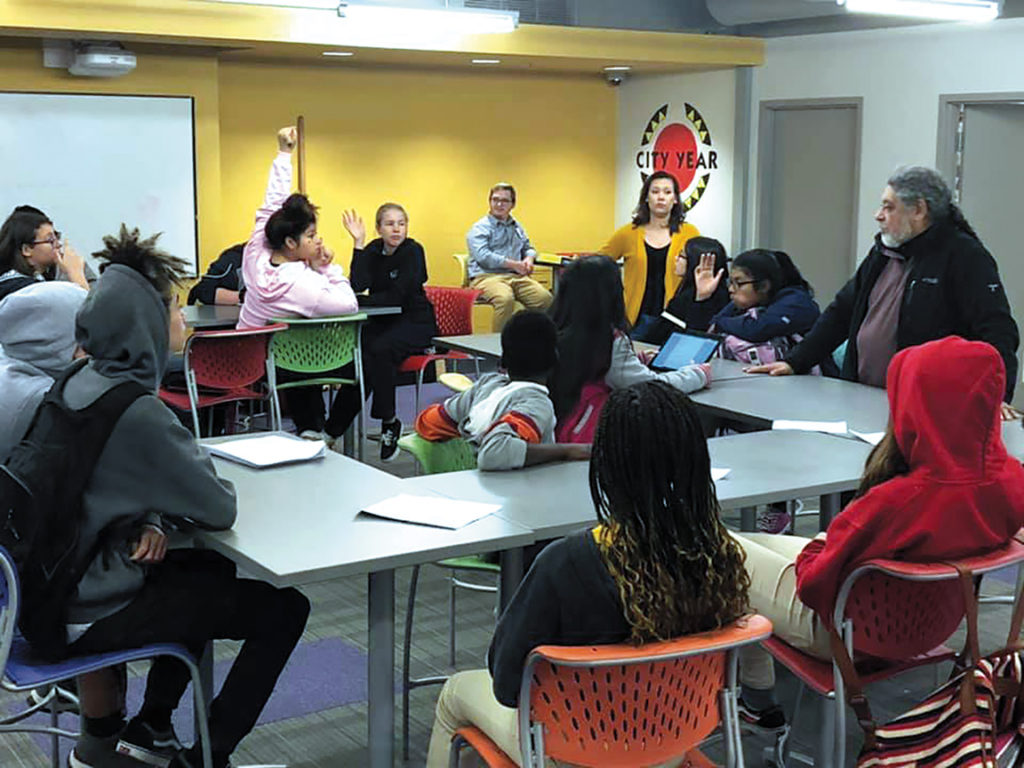
Daisy Garcia Montoya
Editorial Assistant
Northeast Middle School started an Art Mentoring program for students during the 2019-2020 academic school year focused on street art.
The initiative was led by trauma-sensitive school clinician Cristina Marquez and two of her colleagues, school counselor Gina Bumgarner and security officer Sergeant Jeremy Espinoza, who saw a total of 77 participants in its first year.
The idea for the program came during a problem-solving team meeting, which is a multidisciplinary initiative used to talk about the different support services and intervention programs that are brought to Northeast Middle School for students.
Bumgarner said that during the meeting, team members were discussing the different programs and clubs while noting that some students were not interested in the programs being offered.
“They weren’t interested in the clubs or programs we had,” Bumgarner said. “They wanted to skateboard or they wanted to do different art programs and stuff like that. They weren’t interested in typical art programs in normal school settings, they were really interested in graffiti and that kind of stuff.”
When Marquez, Bumgarner and Espinoza started to brainstorm different types of art programs, they eventually settled on one that would focus on street art. Once they received approval from Northeast Middle School administrations they were able to move forward in the planning stage.
Knowing that many students don’t have transportation or the financial ability for support programs outside of school, Bumgarner and Marquez decided to host the program after school. By doing so, students had after-school transportation, further eliminating barriers that often come with extra-curriculars. To make it accessible to all students, the program was open to all, regardless of attendance and behavioral problems so that students could take advantage of Art Mentoring as an outlet.
In the creation of the program, student feedback was taken into consideration to make sure that the program was built around their needs and wants to better serve the students, Marquez said.
“We tried to make it more personal to them,” Espinoza said. “We had a lot of graffiti issues inside the school so we kind of played on that and said, ‘Well, if you’re gonna do that, or you want to learn how to do that, let’s go ahead and do it legitimately.’”
The program ran twice weekly and brought in guest speakers such as tattoo artists and muralists from the community.
Aside from teaching art fundamentals, Marquez, Bumgarner and Espinoza wanted to teach students the process of creating street art, such as asking for permission and creating without offending people by defining what is art and what is considered vandalism.
Students were taught how to build a portfolio and explored the new perspective that creating art could potentially evolve into a lifetime career or business.
Students also learned about Paseo Academy of Fine and Performing Arts, an art-focused school within the Kansas City Public School District, and the application process if they decided they wanted to focus on art.
With classrooms transitioning online due to COVID-19 health and safety guidelines, the opportunity to celebrate the students for participating was not available.
“Thank you, I think the biggest part is we never had an official thank-you at the end, to be able to tell them, you know, thank you for participating,” Espinoza said. “Thank you for letting us teach you something new, showing you something, you know, to look forward to.”
When asked what their favorite thing about the program was, Bumgarner, Espinoza and Marquez all said the students and having the opportunity to work with them in a unique way.
“I love my kids and I just want everything for them and just anything to bring some joy in their life,” Bumgarner said. “They were just so much fun.”
Bumgarner added that community partners are always welcome to help the Art Mentoring Program.
For Espinoza, quality time with the students was the most important part.
“It was the one-on-one connection with the kids, being able to give them a new view on art, how to approach it and how to use it in the future,” Espinoza said. “So they know they can make it a career if that’s something that they want. I think that was a huge part for me.”
As for Marquez, showing them that there are many careers out there such as a profession in art was the most important.
“It was giving them the power to dream that I feel like a lot of times, they don’t think past today,” Marquez said. “In giving them the opportunity to get exposure. Just getting them to see that people that look like them are doing this work and that they could also hopefully see themselves in that capacity as well. So for me, that was kind of just helping the community see our kids in a different light, helping the kids see themselves in a different light.”
Although COVID-19 ended the program sooner than expected, Bumgarner, Espinoza and Marquez said that as long as students remain interested, this program will continue to be offered.



















